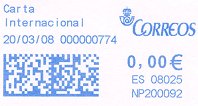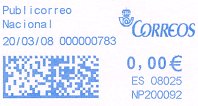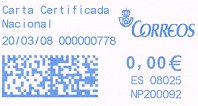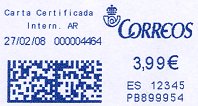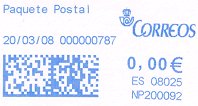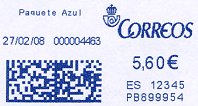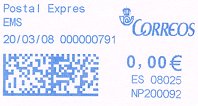| The new digital franking machines and stamps, in Spain |
The winds of change are sweeping through the corridors of the Spanish Postal Service, Correos. New technological systems and processes are being applied to the world of mail and amongst them, the digital technology applied to both franking machines and mechanical franking. This is not our main field of study, but it merits this brief diversion.
In May 2007, Correos started a process of technological renovation of all the franking machines, the so-called technological migration, laid down in Resolution 9096, dated April 23rd 2007, of the Undersecretary's office of the Ministerio de Fomento (Ministry of Public Works). This renovation concerned some 3,500 franking machines in service in private businesses around the country, to incorporate new technological systems that guaranteed the security and control of all the franking processes.
Actually, this process of technological migration assumes that all the franking machines with a manual cash recharge capability (loading of the franking values using a card acquired in post offices) and phone recharge (prior payment to a bank account, and recharging through the phone operator), must be replaced before December 31st 2007 or July 1st 2008, respectively, by new franking machines with digital technology approved by Correos.
| The former mechanical frankings printed in red gives way to a new generation of frankings printed using digital technology. |
 |
At the time of writing this article, there are, in Spain, 3 companies authorized to distribute and maintain the new digital franking machines: They are Pitney-Bowes España, S.A., Ofipack -distributor in Spain for the Neopost machines-, and Global Mailing S.L. -distributor of the Frama equipment-.
| The new digital franking machines |
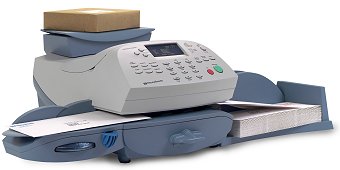 |
A franking machine is, basically, a piece of equipment capable of printing stamps or frankings, for postal shipment, directly onto an envelope or a self-adhesive label, in cases of parcels or large letters. The postal tariff is determined from the weight and the shipping options selected by the user, and the franking amount is automatically deducted from a pre-loaded amount previously acquired by the user and stored in the machine. |
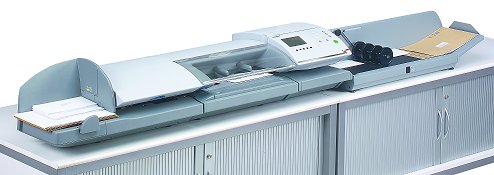 |
Depending on the needs of the user, other groups of mail treatment –such as folding machines, folder inserters etc, can be added to the basic franking equipment, as well as modules allowing for the dynamic weight of the mail. |
| The new franking machines, with digital technology, guarantee a total and reliable control of the franking process. The machines are connected via modems to the distributor's server, which allows for the automatic update of postal tariffs, the quick loading of the franking and the remote control of all the operations. Security is guaranteed by encrypting the information in a sealed hardware component, which is impossible to tamper with. |
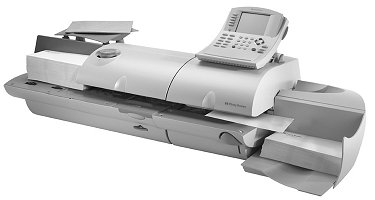 |
For users, the digital franking machines bring different advantages. It allows strict control of the franking costs, even by departments within a company, with the updates and the automatic metering by weight and type of shipment eliminating errors in the franking. It reduces the queues and trips to the post office and allows the printing of advertising messages, or the company logo, next to the franking. In addition, Correos offers a 2% discount off the franking amount, because they consider that the use of these machines makes it easier and / or improves the handling in the mail admission processes.
Despite the evident advantages that the use of these machines offer, it assumes that the postal administration, Correos, has still not taken full advantage of all the facilities, nor have they promoted these features by offering bigger discounts, easier handling / processing, ... to allow a large expansion of the sector in Spain, as has happened in other countries. We only can compare the number of franking machines in service in Spain (approximately 3,500 before the migration, that could be reduced up to 2,000 machines in the first stage after the migration), in front of the approximately 250,000 machines installed in countries like France or Great Britain, 150,000 in Germany, 30,000 in Italy, 28,000 in Sweden ... or the million and half machines in service in the United States ...
 |
The cost and the depreciation of the machines and supplies, the required advance payment to preload these machines and the obligation to prepare delivery notes and to pre-sort the postal pieces items prior to handing them into the Correos post offices, are some of the key factors to be borne in mind by potential users, compared with other franking systems. So it is a system aimed mainly at professional mailing and private companies with a large mail volume. |
| The new digital frankings |
One of the main new features offered by the new digital franking machines is the printing of stamps - mechanical frankings – which include all the information about the shipment, in a unique two-dimensional matrix barcode or Data Matrix.
| Some postal administrations, like Germany, Italy (with the TP label, test right image), Switzerland or the United States (see relevant articles on this website), already use this system of bi-dimensional codification applied to certain stamps, usually those of variable value. |
 |
The current digital franking machines in Spain print the mechanical franking in blue, using inkjet technology, either directly onto the envelope in the upper right corner, or onto gummed or self-adhesive labels, to be affixed on parcels or postal items that, by their size or volume, do not allow for direct printing.
The resulting stamp or franking is sized approximately 50 x 25 mm. It includes a block on the left with the definition of the franking product - National letter, international letter, national registered letter, parcel, express, etc - as selected by the user, (see different options in the images), plus the date of franking, the shipment number and the rectangular Data Matrix code with all the coded information. Companies must print the mechanical frankings and deliver the mail to the assigned post office on the same date as that on the franking.
In the right block there is the identification of the postal administration - Correos, the face value, ES for Spain and 5 digits corresponding to the assigned postal / zip code for delivery of the shipment, plus the machine number -or head printing number- using an 8-digit alphanumeric code. This code starts with the abbreviations PB for the Pitney Bowes equipment, NP for the Neopost franking machines, or FR if it is a Frama machine.
The result is a mechanical franking for immediate use. The postal items with these stamps must be delivered to the assigned post office, on the printed date, and as such do not require any type of postmark or postal cancellation.
 |
On the left side of the mechanical franking, and after the prior consent by Correos, users can include blocks with commercial advertisements, the company logo or any type of message. |
 |
( Note: Some of these mechanical frankings, with the face value 0.00 EUR or fictitious delivery postal codes - ES 12345 or ES 92220, correspond to test printings).
ATM Web - Spain and Latin American Postal Services: http://www.ateeme.net
© J. Jove - M. Sans. ATEEME. Variable value stamps study group. All rights reserved
This page was created in February 2008 and last updated:
29.03.08
. English edition rewritten by S. Goodman (29.03.08)
|







